Suzanne F. Singer, “The Winter Palaces of Jericho,” Biblical Archaeology Review (3: 2) 1977.

Hasmonean Palace in Jericho. By Chaim – Own work, CC BY-SA 3.0, https://commons.wikimedia.org/w/index.php?curid=24377567
For at least 10,000 years, on the plain of the Great Rift, bordered by the mountains of Judea on the west and, on the other side of the Jordan River, the mountains of Moab, there has been a city at Jericho.
The earliest settlement at Jericho—in the Late Stone Age—arose on a hillock close to the spring Ein el-Sultan. This spring, which still gives the city of Jericho its lush appearance amid the otherwise desolate landscape of the Judean Wilderness, made life possible where average annual rainfall is less than four inches a year.
After the Late Stone Age city at Jericho, other civilizations came and went on the same spot, adding debris to the growing mound which today we know as the tell of ancient Jericho. Kathleen Kenyon who excavated at the tell in the 1950’s found life concentrated principally in the area of the tell. Here she also found some of the earliest evidence of cultivation.
In the second century B.C. the Hasmonean kings of Israel, descendents of the Maccabees, came to Jericho. They were the first to efficiently harness the water from the several rich springs in the nearby Judean mountains to take advantage of the agricultural possibilities of the wider Jericho plain. The Hasmoneans built a series of aqueducts from the springs in the hills to the plain of the Great Rift.
Read the rest of The Winter Palaces of Jericho in the online Biblical Archaeology Society Library.



